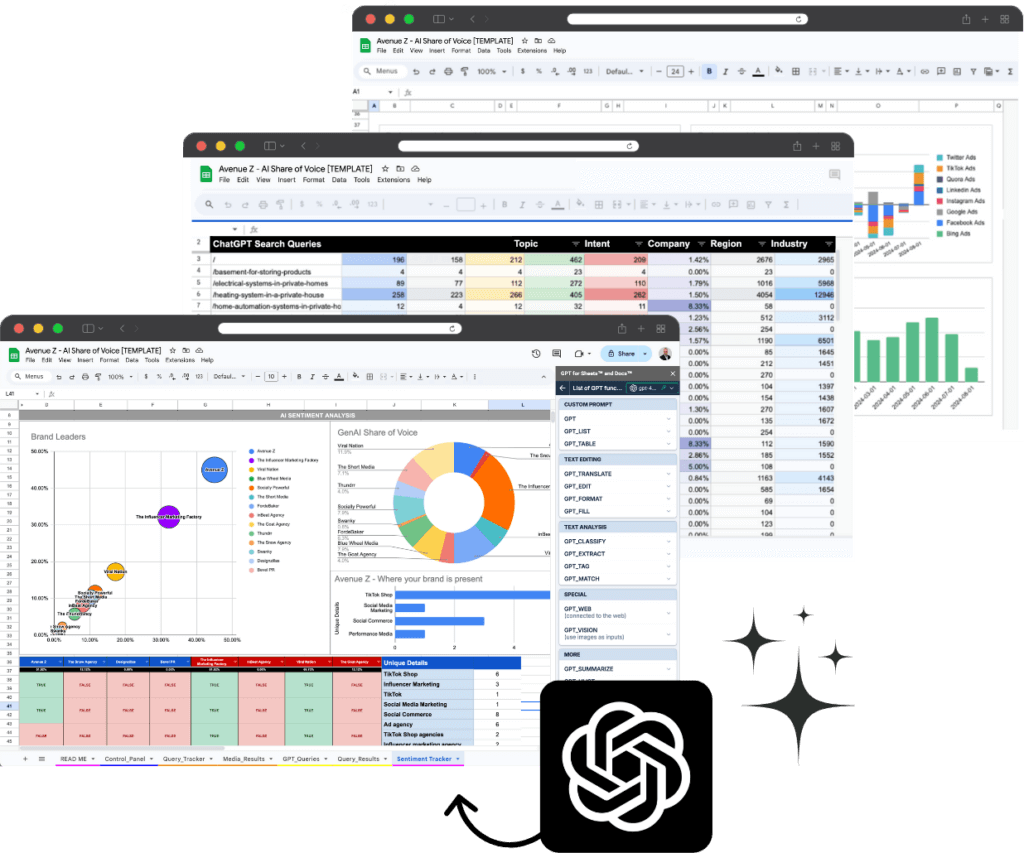We just tested SEMrush’s new AI Toolkit, and while it’s a solid step forward for AI-powered search visibility tracking, it’s not exactly groundbreaking. The tool provides market share insights, sentiment analysis, competitive perception metrics, and audience behavior tracking across platforms like ChatGPT, Gemini (Google AI), and Perplexity AI.
For brands that need a broad overview of their presence in AI-driven search, this toolkit is useful—but we’ve found that a more tailored approach, like our own AI Share of Voice tool, delivers deeper, brand-specific insights.
That said, SEMrush’s AI Toolkit still has its strengths; here’s where it delivers value.
Table of Contents
1. Market Share Insights: How Visible Is Your Brand?
The AI Toolkit tracks how much visibility your brand has in AI-powered search results and how it compares to competitors.
- Market Share Percentage – What portion of AI-driven search traffic does your brand command?
- Market Share Trends – Are you gaining or losing visibility over time?
- Market Share Distribution – Which competitors are capturing the most AI search share?
Example Insight: SEMrush’s analysis showed that Warby Parker holds a 29% market share, ahead of competitors like Eyebuydirect and Zenni optical.
2. Sentiment Analysis: What’s Driving Brand Perception?
SEMrush’s AI Toolkit breaks down brand sentiment into positive, neutral, and negative mentions, helping businesses understand consumer perception at scale.
- Overall Sentiment Score – Measures the percentage of positive, neutral, and negative feedback.
- Consumer Engagement – Tracks how actively customers interact with the brand.
- Key Sentiment Drivers – Divided into Brand Strengths and Areas for Improvement.
Example Insight: Warby Parker’s 88% positive sentiment was driven by its home try-on program, affordability, and stylish frames. However, limited selection and weak in-store presence were flagged as negatives.
3. Query Intent Distribution: How Are People Searching for Your Brand?
Not all searches are the same—SEMrush’s AI Toolkit categorizes consumer intent, breaking down how people engage with a brand:
- Research (63.5%) – Users gathering general information.
- Comparison (14.8%) – Evaluating brands against competitors.
- Education (8.3%) – Learning about industry topics.
- Support (7.7%) – Seeking customer service or troubleshooting.
- Purchase (6.8%) – High-intent buyers ready to convert.
Example Insight: Warby Parker saw a high number of research and comparison queries, meaning potential customers were still in the decision-making phase rather than purchasing.
4. Market Share by Platform: ChatGPT, Gemini, and Perplexity AI
Different AI-powered search engines prioritize different results. SEMrush’s AI Toolkit measures brand visibility across:
- ChatGPT – Strong for brand awareness and conversational search.
- Gemini (Google AI) – Tied closely to Google’s evolving search algorithms.
- Perplexity AI – A rising AI search engine focused on research-heavy queries.
Example Insight: Warby Parker had stronger visibility on ChatGPT than on Gemini, meaning its content strategy works well for conversational AI but might need adjustments for Google’s AI-driven search results.
5. Competitive Perception by Platform: How Do You Rank vs. Competitors?
SEMrush’s AI Toolkit provides a side-by-side competitive sentiment analysis across major platforms, showing:
- How consumers perceive your brand vs. competitors.
- Which AI search platforms drive the most positive sentiment.
- What factors influence consumer perception on each platform?
Example Insight: Warby Parker’s sentiment perception was strongest on ChatGPT but weaker on Gemini, suggesting it needs a better strategy for Google AI search visibility.
Final Verdict: Is SEMrush’s AI Toolkit Worth It?
SEMrush’s AI Toolkit is a valuable tool for tracking AI-driven search market share, sentiment analysis, and query intent distribution. It provides useful insights into how brands perform across AI-powered search engines like ChatGPT and Gemini, helping marketers understand competitive positioning and audience engagement.
However, the tool lacks deeper brand-specific analysis and does not offer a detailed breakdown of how AI-generated content is shaping consumer decisions. The additional cost of $99 per month per domain may also be a drawback for some businesses.
For brands that need a broader view of AI search visibility and sentiment tracking, SEMrush’s toolkit is a solid option. But for businesses looking to go beyond rankings and understand how their brand narrative is forming across AI-generated search and media, a more comprehensive solution like Avenue Z’s AI Share of Voice tool is the better investment.
Need a strategy to improve your AI search visibility? Talk to our experts today.
Want Free Access to our AI SOV Template?
Getting started with AI SOV tracking can feel complex. That’s why we’ve designed a free AI Share of Voice Tracker Template to help you stay ahead without the steep learning curve.
This tracker is an invaluable resource for any brand looking to solidify its AI search presence, whether you’re a digital native or just beginning to explore AI search strategies.







